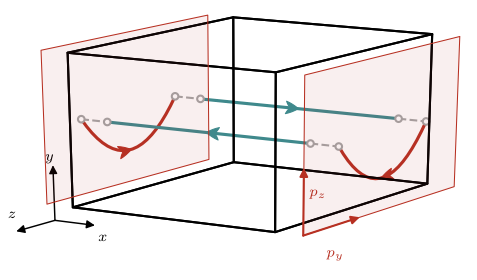Weyl conveyor belt
Weyl semimetals display unique transport phenomena in the presence of external fields: Weyl orbits realize a conveyor belt that shuttles electrons through bulk and along surfaces. But is a magnetic field essential to observe these closed trajectories?

External magnetic fields lead to one-dimensional unidirectional channels in the bulk of Weyl semimetals. These channels are separated in momentum space rather than real space. Therefore, Weyl systems in a magnetic field are the 3D reciprocal space counterpart of the real space 2D integer quantum Hall effect. An electron residing on these channels gets transported through the bulk and reaches the surface. There, the Lorentz force drives the electron along equi-energy lines to the projection of a counter-propagating bulk channel where it gets reabsorbed in the bulk. All in all, electrons experience a conveyor belt motion between surface and bulk.
It is not always feasible to achieve magnetic fields sufficiently strong to observe clear signatures of closed Weyl orbits. Moreover, only electrically charged particles couple to electromagnetic fields. In this work, we show how one can realize conveyor belts even in the absence of external magnetic fields. Inhomogeneous profiles of strain or magnetization alone can do the job and drive non-local Weyl orbits.
Our study opens the possibility to observe Weyl orbits in engineered platform, e.g., classical metamaterials and ultracold atoms, where the particles are electrically neutral. Breaking free of external magnetic fields, also allows to tune on-and-off the conveyor belt using only surface probes. An intriguing feature for future technological applications of Weyl semimetals.
Peri V, Dubček T, Valenti A, Ilan R, Huber SD. Weyl orbits without an external magnetic field external page arXiv:2004.04175